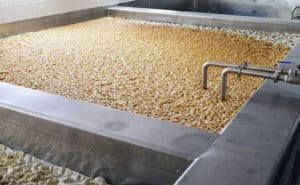If you prefer stronger beers with higher alcohol content, you can sound like a true beer enthusiast by talking to your friends about high-gravity brewing. The concept is simple enough, but using the right vocabulary will make you seem like a beer expert. Best of all, you can enjoy one of your favorite beverages at the same time. Here’s the lowdown on this niche of craft beers.
 What is the high-gravity brewing process?
What is the high-gravity brewing process?
High-gravity brewing uses a process of preparing a type of wort with a high-gravity content to produce a beer with a higher ABV. Wort is the term used to describe unfermented beer, or in other words, beer before it has been fermented. Let’s break this down further. Before any adjustments are made, the unfermented liquid, or wort, will have a measurement of original gravity. Original gravity measures the number of dissolved sugars in the beer that can be converted into alcohol during fermentation. A solution with more sugars will mean more alcohol. Most beers will have an original gravity of 10°–13° Plato. Brewers will then make adjustments by adding more grains, malts, or sugars depending on the style of beer they are producing.
Whoa, what’s Plato?
Ready to start sounding really smart? The Plato gravity scale is a measurement of the dissolved sugars in the substance. The degrees represent the concentration of sugars and any other soluble material in the wort as a percentage of its weight. For example: A 10°P wort will contain 10 grams of extract per 100 grams of wort. It’s these substances that will be converted to alcohol as the liquid ferments. Brewers estimate the final ABV of a beverage based on the degrees Plato. On average, each 1°P will increase the ABV by about 0.4%. As an example, 12°P wort will end up being about 5% ABV depending on which sugars are digested during fermentation.
What makes a high-gravity beer?
Brewers who are aiming to produce a high-gravity beer adjust the wort until it is between 14°P and 17°P. With that Plato gravity, the final beer should end up being 6% to 8% ABV. A very high-gravity wort is one with more than 17°P and will end up having an ABV of around 8%. Styles of beer that are most commonly produced with high-gravity worts include:
- Barley Wine
- Imperial Porter
- Imperial Stout
- Scotch Ale
- Imperial Ale
- Wheat Wine Ale
- Barrel-Aged Beer
- Belgian-Style Golden Strong Ale
Why else do brewers make high-gravity beer?
The goal for all brewers isn’t to make the strongest, high-ABV beverage possible. Instead, some brewers use this process to economically expand their production capability. A very high-ABV beverage can be treated like a concentrate. While the same amount of liquid is produced, it can later be expanded by adding water to it until the ABV and the taste is where the brewer wants his final result to be.
Learn more about beer with a visit to The Growler Guys.
Explore the growing variety of beers in one taproom, The Growler Guys. Each location carries the best local varieties, from the palest ales to the darkest stouts, along with ciders and kombucha. Our friendly staff is happy to walk you through the characteristics of every style to help you discover your personal favorites. Take home the beers you love best in a growler to share with family and friends. View our online tap list to learn about the available selections at a location near you.

 What is the high-gravity brewing process?
What is the high-gravity brewing process?
Reader Interactions